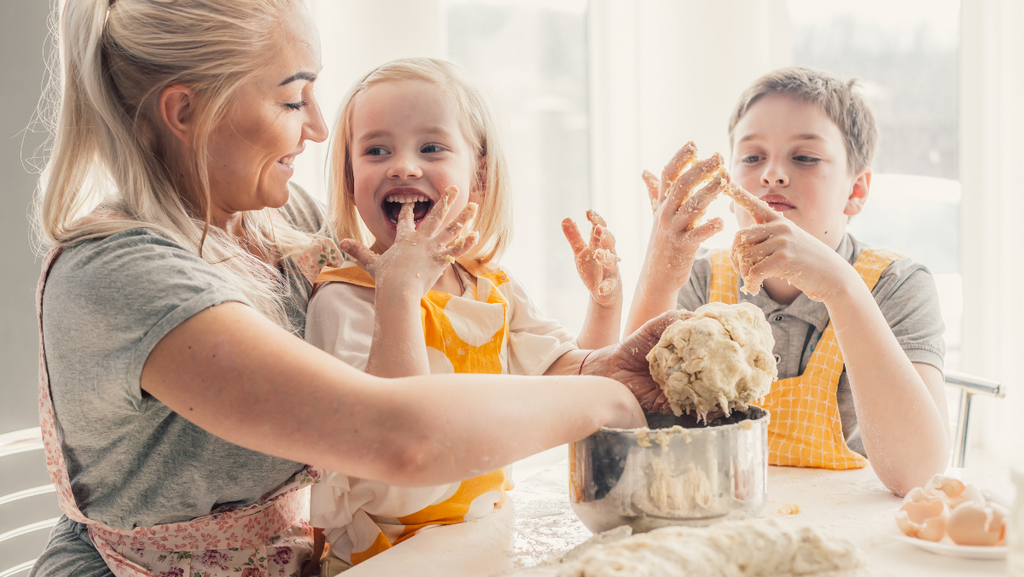Cooking with kids can be a rewarding experience, fostering creativity, curiosity, and valuable life skills. However, ensuring child safety in the kitchen is paramount. With a few simple guidelines and precautions, you can create a safe and enjoyable cooking environment for your little ones.
Child safety in the kitchen is a top priority for parents, as it involves potential hazards like sharp objects, hot surfaces, and electrical appliances. But with the right approach, cooking with kids can be both safe and fun. Let's explore some practical tips and strategies to navigate the kitchen with your children safely.

Setting Up a Safe Environment
Creating a safe environment in the kitchen is the first step to cooking with kids. It's not just about having the right ingredients and recipes; it's about ensuring that every aspect of the kitchen is conducive to the safety and well-being of your little ones.
From preventing access to sharp objects and hazardous materials to establishing clear boundaries and designated safe zones, every precaution you take contributes to a secure and enjoyable cooking environment.
Childproofing the Kitchen
Childproofing your kitchen is the first line of defence in keeping your little ones safe while they explore the culinary world.
Start by meticulously securing cabinets and drawers with reliable child locks. These locks act as barriers, preventing access to sharp objects like knives and scissors, as well as potentially harmful cleaning supplies and chemicals.
Safe Zones
Designating safe zones within your kitchen is an essential strategy for fostering a secure environment where kids can actively participate in cooking activities. These designated areas serve as controlled spaces where children can engage in age-appropriate tasks under the watchful eye of an adult.
Keep these zones free from hazards and clutter, ensuring that surfaces are clean and tools are within reach. Whether it's a low countertop for mixing ingredients or a designated table for assembling dishes, these safe zones empower children to explore their culinary curiosity while minimizing the risk of accidents.

Educating Kids About Kitchen Safety
Empowering children with knowledge about kitchen safety is paramount to their understanding and awareness of potential hazards.
Involve kids in age-appropriate cooking tasks, such as mixing ingredients, measuring, and stirring. Use these opportunities to teach them about safe handling of utensils and appliances.
Establish clear safety rules for the kitchen, such as washing hands before and after handling food, using oven mitts when touching hot surfaces, and never touching sharp objects without adult supervision.
Supervision and Communication
Active supervision and open communication are vital components of maintaining a safe environment for children in the kitchen. By actively supervising and fostering open communication, you create a collaborative atmosphere where children feel empowered to explore and learn while minimizing potential risks.
Supervision
Active supervision means being fully present and engaged while children are in the kitchen. Keep a close eye on their activities, especially when they are using appliances, handling sharp objects, or cooking on the stove.
Actively intervene when necessary to prevent accidents or unsafe behaviours. Position yourself strategically in the kitchen to have a clear view of your children and the cooking area, ensuring that you can respond quickly to any potential hazards.
Communication
Encourage open communication with your children about kitchen safety. Create a supportive environment where they feel comfortable asking questions and expressing concerns. Listen actively to their thoughts and observations, and provide clear explanations and guidance.
Use age-appropriate language and examples to convey important safety messages effectively. Foster a culture of trust and respect, where children feel valued and empowered to voice their opinions and contribute to discussions about safety practices in the kitchen.

Age-Appropriate Tasks
Assigning age-appropriate tasks to children is a fantastic way to foster their confidence and independence in the kitchen. Tailoring tasks to their abilities ensures they can actively participate while learning valuable skills along the way.
Here are some suggestions for age-appropriate tasks:
For Young Children (Ages 2-5)
Washing fruits and vegetables: Let young children rinse fruits and vegetables under running water. This simple task teaches them about food preparation and cleanliness.
Tearing lettuce or herbs: Encourage children to tear lettuce leaves or herbs for salads. It's a safe and enjoyable activity that develops their fine motor skills.
Mixing ingredients: Allow them to mix ingredients in a bowl using a spoon or spatula. This hands-on task introduces them to basic cooking techniques while promoting independence.
For Older Children (Ages 6-12)
Cracking eggs: Teach older children how to crack eggs into a bowl without getting shell fragments into the mixture. This task improves their coordination and confidence in handling delicate ingredients.
Measuring ingredients: Have them measure out ingredients using measuring cups and spoons. This teaches them about precision and accuracy in cooking while reinforcing basic math skills.
Using kitchen tools with supervision: Under adult supervision, let children use simple kitchen tools like a whisk, pastry brush, or rolling pin. This hands-on experience enhances their understanding of kitchen utensils and their functions.
As children grow and develop, you can gradually introduce more complex tasks and responsibilities based on their abilities and interests.

Conclusion
Cooking with kids is a wonderful way to bond as a family and instil valuable life skills. By prioritizing child safety in the kitchen and following these guidelines, you can create a positive and secure cooking environment for your children. With proper supervision, education, and communication, you can enjoy the joys of cooking together while keeping your little ones safe every step.
Please browse our products or contact us if you need assistance.
